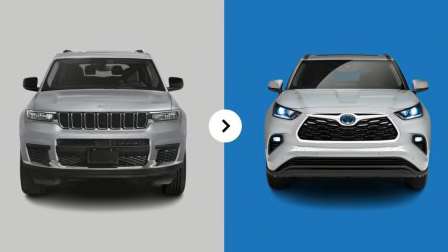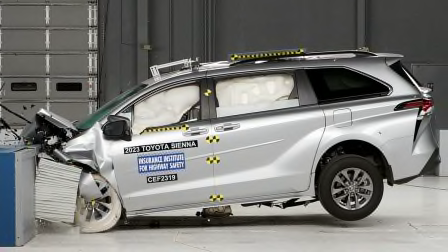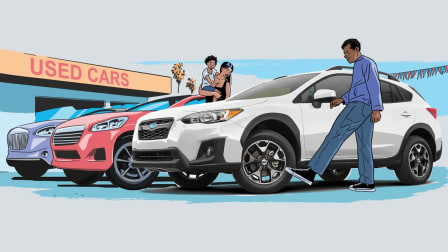50 Years of Airbag Safety—and Challenges
Thousands have survived crashes since they've been required—but some airbags are now under recall. Here is what you should know about those problems, and the latest technology.

It has been 50 years since the introduction of the airbag, and on this anniversary there is a remarkable story of safety to tell.
The stats are astounding: Frontal airbags have saved over 50,000 lives in the U.S. alone, according to data from the National Highway Traffic Safety Administration. They reduce driver deaths by 29 percent in front-end crashes, and fatalities of front-seat passengers 13 and older by 32 percent.

When a Crash Happens
Sensors in the front of the vehicle determine whether the impact is severe enough for the airbags to deploy. If it is, the inflators fill the airbags. The entire process takes place in less than 0.05 second. Airbags placed throughout the vehicle prevent passengers from colliding with the interior surfaces of the car as well as with each other. They also protect passengers by spreading the energy of an impact over a larger surface, minimizing the force on the body.
But safety experts are adamant that the benefits of airbags far outweigh any risks.
"Airbags remain overwhelmingly safe and highly effective at saving lives and preventing injuries," says Emily A. Thomas, PhD, manager of auto safety at Consumer Reports.
Becky Mueller, senior research engineer at the Insurance Institute for Highway Safety, agrees. "Airbags are still far more likely to protect you in a crash than they are to cause you harm," she says.
Safety experts also say it’s critically important for consumers purchasing a car to understand the various types and configurations of airbags and, if buying a used car, to make sure its airbags are not subject to a recall and are in good working order. Here, the story behind airbags in modern cars, and what you need to know about them when buying a vehicle.
In Focus: Best Cars of the Year and Top Car Brands
See CR’s 10 Top Picks of 2024, find out who makes the best vehicles, and learn more in our annual report on car performance, reliability, owner satisfaction, and safety.
When Cars Became Safer
For many years, cars lacked much in the way of safety equipment. In fact, it wasn’t until 1968 that automakers were required to install lap and shoulder belts in the front seat.
But no laws required people to use those seat belts. (New York became the first state to enact a seat belt use law, in 1984.) Consequently, in the late ’70s and early ’80s, less than 14 percent of Americans wore seat belts. In a crash, unbelted passengers were often seriously injured or killed after being flung into metal dashboards, or ejected when doors flew open and windows shattered.
In 1974, General Motors introduced a more primitive version of today’s airbag as a $235 option on certain Buick, Cadillac, and Oldsmobile models. Called the Air Cushion Restraint System, it incorporated air cushions hidden in the steering wheel and under the instrument panel that would deploy in a crash. A main selling point was that it could keep you and your front-seat passenger safe while wearing only a lap belt, requiring "no shoulder belts to confine movement or detract from the car’s interior appearance."
GM’s airbag option didn’t catch on with the public, and it was quietly discontinued just two years later. But automakers kept on experimenting with airbags, and in 1988 Chrysler began to promote them as a standard feature in most of its cars.
Early airbags saved lives, but they also deployed with greater force than today’s do, and as a result, they injured and killed people. NHTSA estimates that airbags were the cause of more than 290 deaths between 1990 and 2008—mostly unbelted children or infants riding in the front-passenger seat. Advances in airbag technology, including reducing the force of deployment and adding weight sensors that detect a smaller driver or passenger, have almost eliminated injuries and fatalities caused by properly functioning airbags. (NHTSA says that all children younger than 13 should ride in the back seat regardless of airbag advancements.)
And while airbags are required only for the driver and front passenger, they are commonly found throughout cars today (see the interactive above). "Safety programs like the IIHS vehicle ratings help raise the bar beyond what the government requires," Thomas says. "This incentivizes automakers to engineer safety solutions to be competitive among their peers."

Photos: IIHS Photos: IIHS
New Safety Concerns
Last spring, NHTSA took initial steps toward a recall of as many as 52 million airbags made by Tennessee-based manufacturer ARC and a licensee. Similar to the Takata recall, the problem is with allegedly defective inflators that can spray metal fragments into the car when the airbags deploy in a crash. As of December 2023, seven injuries and one death in the U.S. have been connected to the ARC airbags, according to NHTSA.
ARC has so far resisted NHTSA’s efforts to force a recall, but General Motors last year voluntarily recalled nearly a million of its 2014 to 2017 models that could be affected. At publication time, GM was the only automaker of 12 using the ARC bags to have issued a broad voluntary recall related to the possible defect.
CR’s Thomas says that while news of the possible ARC airbag defect is concerning, the risk to the public is low. "The chance of being in a crash in which a defective airbag deploys is very small," she says. NHTSA estimates the risk of malfunction of an ARC airbag to be roughly 1 in 371,400.
Thomas advises car owners to check the NHTSA website (at nhtsa.gov/recalls) at least every six months to learn about any recalls affecting their vehicle, including any related to airbags.
The Airbags to Look For
Only driver and front-passenger airbags are required in cars, but almost all models also come with front-seat side airbags and side curtain airbags because they help carmakers meet federal requirements for protecting passengers in a side-impact crash. But other types of airbags are also available and may be a good choice if they’re available in the car you’re considering. Here is info about additional airbag options and other important airbag-related safety considerations to make when you shop for a new or used car.
Consider rear-side and front-center airbags. Emily A. Thomas, CR’s car safety expert, says that whether you need these depends largely on how you use your car. "You want the highest degree of protection for all your passengers," she says. "If you always or often have people in the back seat, you’ll want rear-side airbags."
Similarly, Thomas says, you may want to consider a front-center (also called far-side) airbag for extra protection, especially if you often ferry a front-seat passenger. Located between the two front seats, it is designed to prevent the driver and front-seat passenger from hitting each other or the vehicle interior in the event of a side impact to the vehicle.
Check the vehicle’s crash-test ratings from NHTSA’s New Car Assessment Program (NCAP) and the Insurance Institute for Highway Safety. These measure a vehicle’s performance in crash tests, including how well the airbags work to protect passengers from injury. You will find the NCAP star rating on the vehicle window sticker of most new cars. For used cars, you search for the rating.
The IIHS vehicle rating is at iihs.org/ratings. "The IIHS tests have been more frequently updated than NHTSA’s, so they are a stronger predictor of real-world crash protection," Thomas says. Look for vehicles that have the Top Safety Pick or Top Safety Pick+ designation from the IIHS. (See the safest new cars of 2023 according to IIHS.)
Make sure the airbags are not subject to an open recall. While federal law specifically bans the sale of a new car with an open recall, that’s not true for used cars. To find out whether the used car you are thinking of buying has a recalled airbag, enter its 17-digit vehicle identification number (VIN) at nhtsa.gov/recalls or on NHTSA’s SaferCar app for Apple iOS and Android. If the vehicle has any open recalls—airbag-related or otherwise—have the seller address them before you buy the car.
If you’re considering a used car, get a vehicle history report from AutoCheck or Carfax. The report will indicate whether the car has been in any crashes that resulted in airbag deployments. "If a car’s history report shows that its airbags have deployed, consider walking away," says CR auto technician Mike Crossen. "If airbags deployed, the impact could have been forceful enough to cause structural damage to the vehicle that you may not see." (Some dealerships provide the reports free of charge.)
Have an experienced technician inspect any used car before you buy it. "They will check for airbag fault codes, which, if present, would indicate a problem with the car’s airbags," Crossen says.
Editor’s Note: This article also appeared in the April 2024 issue of Consumer Reports magazine.



















